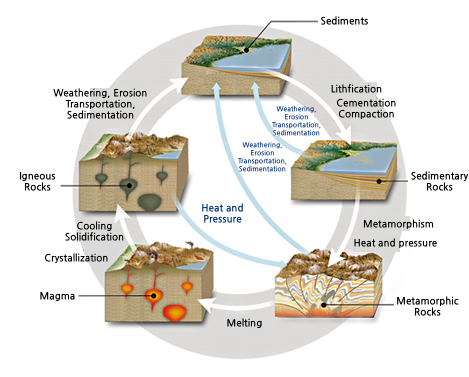Primitive Earth and Rock Cycle
About 4.6 billion years ago, the primitive Earth was born as a result of the collision and aggregation of numerous planetesimals drifting around the coeval primordial sun. The surface of the newborn Earth was a sea of liquid magma, but a thin, solid crust was gradually formed as the frequency of collisions decreased (4.2 through 4.0 billion years ago).
Rain falling from the primordial atmosphere composed of vapor and carbon dioxide, formed the primitive oceans (nearly 3.8 billion years ago).
The Earth had a concentrically stratified structure with hot magma at depth, a thin crust at the surface partly covered by seas, and surrounded by the atmosphere. Then the Earth started its life as a planet.
As the crust was formed, magma, molten matter below the Earth's surface, partly cooled and solidified to form igneous rocks. Fragments derived from the solid crust by weathering and erosion were transported and settled to be transformed through lithification (compaction and cementation) into sedimentary rocks. When buried more deeply, both igneous and sedimentary rocks responded to higher temperatures and pressures by changing their form into metamorphic rocks.
All the rocks of the Earth are being recycled continuously, crossing the boundaries among three main rock classes. This process is called as “rock cycle”.


Rock Cycle
As surrounding conditions change, rocks on Earth are being recycled continuously, crossing the boundaries among three main rock classes.